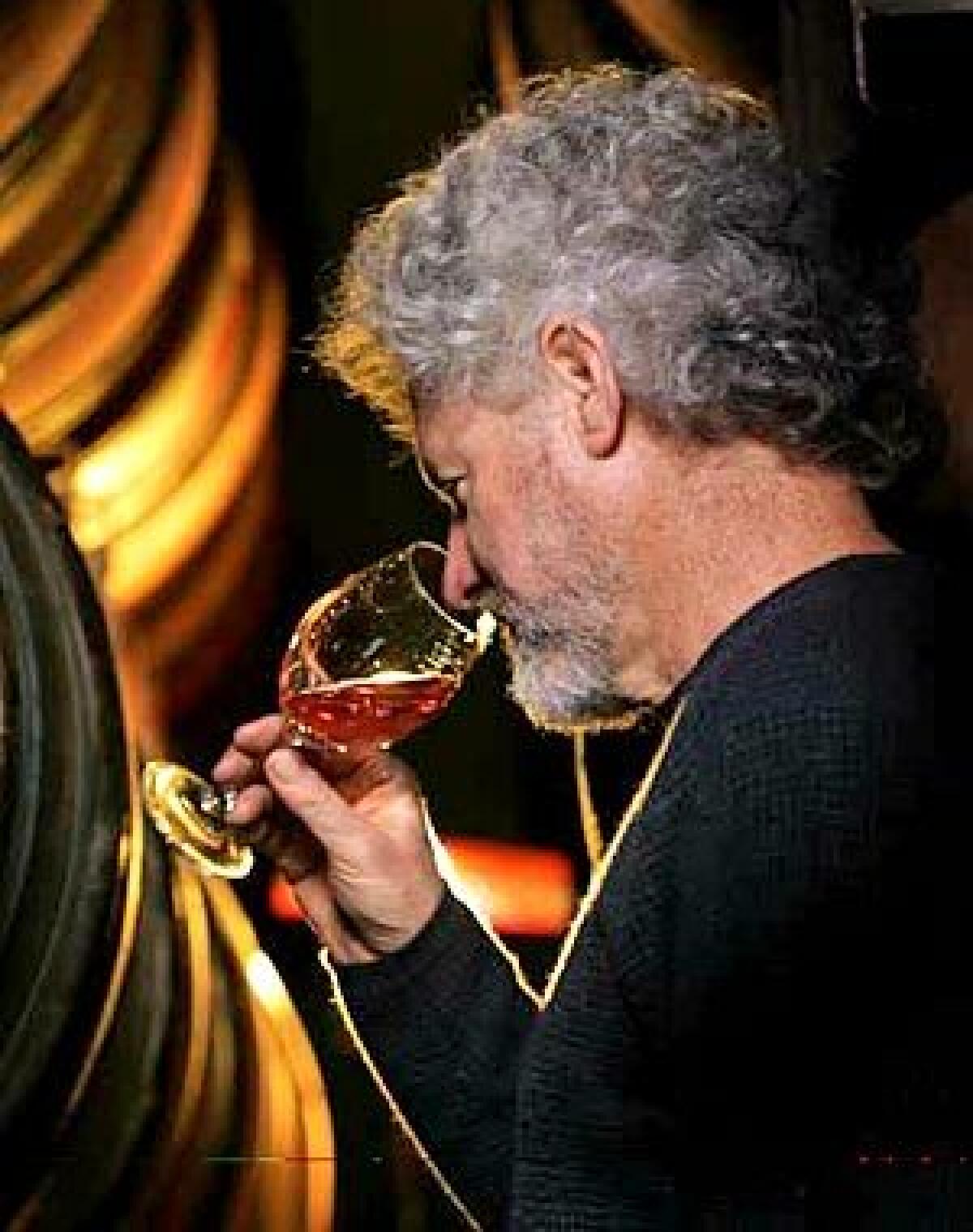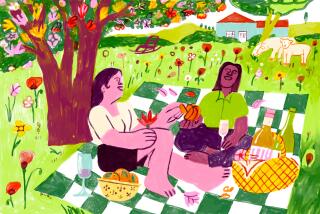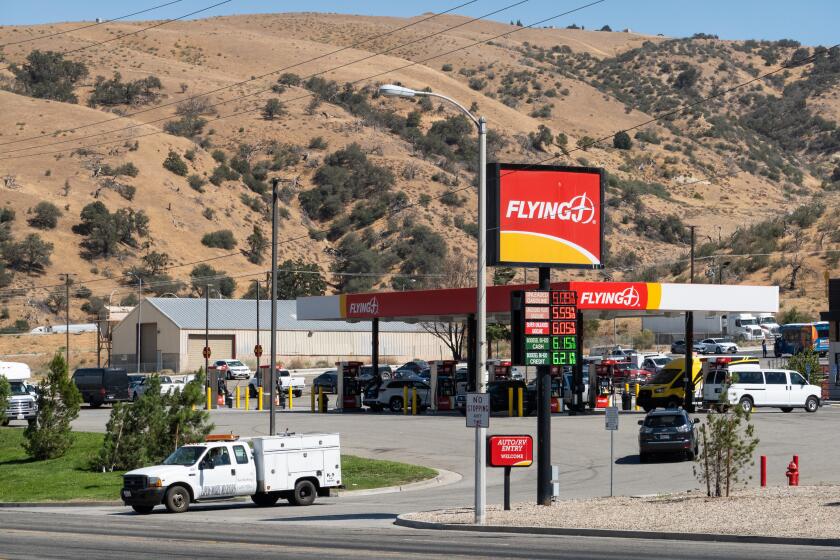Are California wines over the top?

- Share via
OJAI — ONE after another, the bunches of soft or raisiny grapes in the rejection bin pile up. Adam Tolmach and his Ojai Vineyard crew are sorting the last grapes of the 2007 harvest, and 1 in 10 purple clusters aren’t making the cut. It’s the third week in October, an early finish -- or early for Tolmach, who produces opulent Chardonnay, Pinot Noir and Syrah wines. Next year’s harvest, he says, could be even earlier, and the following year may be earlier still. Tolmach is pushing up his harvest dates to pick less-ripe grapes and rejecting bunches that might have made the grade in previous vintages to bring his wines back in balance -- a balance he says he lost in the years spent trying to serve two masters: himself and wine critic Robert Parker.
After 25 years, Santa Barbara’s original cult winemaker has had a crisis of conscience. “We got the scores we wanted, but we went away from what I personally like,” Tolmach says. “We lost our rudder when we went for ever bolder, riper flavors.” Specifically, he says, the alcohol levels of his wines, at 15% and higher, are too high.
Graying corkscrew curls poke out from under his floppy hat as Tolmach stands in the doorway of one of the small, wood-frame buildings around the edge of the open-air cement pad where he makes 6,000 cases of wine a year, including his Melville Syrah and Clos Pepe Pinot Noir. The makeshift winery, a rustic hideaway near Ojai, sits on land left to him by his grandfather. As he steps out into the sun, signaling to his crew to follow him up the stone steps to his house, where he’ll make them a lunch of grilled cheese and onion sandwiches, he says, “We have to do the right thing. I’d stopped drinking my own wines.”
It’s an unprecedented statement. In the ongoing debate about how big is too big for California wines, it’s unusual for such a well-respected vintner to even weigh in, much less declare he’s made a mistake by making wines that receive critical acclaim. And then to say he’s changing course and expects his future wines might be less popular with those same critics? Well, that just never happens. The market for premium wines is enormously influenced by ratings such as those in Parker’s Wine Advocate newsletter. At this point, most consumers who are willing to spend the $40 to $60 Tolmach charges for a bottle are disappointed if a California wine doesn’t deliver the kind of fireworks Parker praises.
Ripe for a change
BUT Tolmach thinks American consumers will respond, as their European counterparts do, to balanced, lower-alcohol wines -- if they’re offered the option. “Low-alcohol” is no longer synonymous with thin and acidic, he says. With careful vineyard management, it is possible to retain rich flavors without sending alcohols soaring. And he will do it, he says, without adding water or physically removing alcohol -- two controversial winemaking tricks common in California.
The goal is to produce 14%-alcohol wines with nuance, Tolmach says. He wants to avoid overripe prune and jam flavors and preserve acidity to allow the more delicate floral and herbal qualities to emerge. “I want to take the Eurocentric sense of balance and apply it in California. We add no acid. No water. It’s about picking at the right time and from cooler climate vineyards,” he says.
“By farming better, I can have full ripeness earlier,” he says. It’s a matter of spending more time in the vineyard to reduce grape yields in stages while increasing the leaf canopy to shade the grapes from too much sun. Naturally balanced wines produced naturally, he says.
Tolmach isn’t interested in going back to the early 1980s when his Ojai Vineyard wines contained 12% and 13% alcohol. With many California wines now weighing in at 16% alcohol and higher, he considers 14% restrained.
Looking for balance
TOLMACH isn’t the only vintner to come to this conclusion. “Take any 20 winemakers, and they are all thinking about alcohol levels,” says Joe Davis, owner of Arcadian Winery, a Pinot Noir vintner in Solvang and an outspoken advocate of lower-alcohol wines. His wines have rarely surpassed 14% alcohol.
Winemaker Ray Coursen decided to dial back the alcohol levels in his Napa Valley Elyse wines because sales were slipping. “We found ourselves making wines that were 16.2% and 16.4% alcohol, which is very easy to do in California,” Coursen says.
“There is a lot to be said for these bigger wines. But one thing is certain, two people can’t share a bottle with dinner.” The wines overwhelm the meal, Coursen says. “We have to adapt. You are going to see more vintners change.”
Like Tolmach, he’s following a slow process of small changes in the vineyard and avoiding adding water during fermentation and other winemaking tricks. He’s harvesting extremely small vineyard sections as they ripen, rather than waiting for all of the grapes in a vineyard to reach a minimum level of ripeness.
Top restaurants want wines with lower alcohol levels, says James Hall, winemaker and partner in Patz & Hall in Sonoma.
“The new generation of sommeliers is more internationally oriented. They like wines with finesse.”
Hall is picking his grapes earlier, if only by a few days. “We’ve been doing it since 2002,” he says, but because of high temperatures the following two years, the shift wasn’t notable in the bottle. In 2005, he says, he moved closer to his goal with wines under 15% alcohol. “I’m not that obsessive about alcohol levels, but I do want balance.”
Still, “Adam is courageous,” says Davis. “To have a winning combination and then stand up and say you are changing, it’s not easy.” In fact, it’s foolhardy. Anyone spending what it takes to make high-quality wine in California absolutely has to sell that wine for at least $35 a bottle, Davis says. “Those wines sell on critical scores. And if you don’t have the scores, you don’t sell your wines.”
Critical support
TOLMACH thinks that other wine critics are beginning to get the attention of wine lovers. For example, Allen Meadows, an L.A.-based authority on the wines of Burgundy and Champagne, has, for the last two years also been critiquing American Pinot Noir in his influential Burghound newsletter. There’s now an alternative to the bigger-is-better point of view on wines, at least for Pinot Noir.
“It’s taken a while for American Pinot to get up to world-class standards,” Meadows says. “They went from thin and reedy to Pinot-on-steroids.”
Now the wines are starting to swing back toward more balance, he says. “There are glimpses that great Pinot is possible here.”
In his latest newsletter, Meadows calls the 2005 vintage the best yet for Patz & Hall wines. “The relative toastiness that their Pinots have exhibited in the past is almost invisible.” Arcadian wines rank among his favorites. And Tolmach’s earliest success in scaling back alcohol levels -- the 2005 Clos Pepe Pinot Noir -- is applauded for its “solid tannic spine and good acid/fruit/structure balance.”
“I flatly disagree that a 15% alcohol wine can be balanced,” Meadows says. He skewers some of the California Pinot Noir wines that Parker routinely celebrates.
After Parker awarded the 2004 Pinot Noir Cuvée Elizabeth Bodega Headlands Vineyardfrom Kistler Vineyards in Napa Valley a 94/95 on his 100-point scale, Meadows gave the wine an 86 out of 100 points. “While the size and weight and concentration are impressive, the texture is anything but elegant,” Meadows wrote.
California’s ever-present sunshine produces ripe fruit as a matter of course. Ripe wines, with their generous fruit flavors and lush, round opulence, can be appealing stand-outs when compared with more understated wines. Ready to drink when they are released by the winery, they offer instant gratification rather than requiring time in a cellar to mature.
But in recent years, there has been a growing sense among sommeliers, wine retailers and some wine lovers that a line has been crossed, and California wines are too ripe.
“For some time,” Meadows writes in the latest issue of Burghound, “there has been a heavy emphasis on ultra ripe fruit . . . and opulent texture. Happily, these extreme wines are becoming less prevalent.”
In California, grapes can hang on the vine until they are raisins without rotting, Tolmach says. “The flavors lose freshness and liveliness but they do get more amplified.” As these overripe wines gained popularity, he found he was drinking more and more European wines and fewer California wines, including his own.
European blueprint
IN his kitchen, Tolmach opens the door to the closet he’s turned into his personal wine cellar. The floor-to-ceiling racks are filled with Burgundy wines from Nicolas Potel, Domaine Dujac and Domaine Leroy. There are Rhône wines from Alain Graillot and Chapoutier, German wines from Heymann Löwenstein and Emrich Schönleber, and some Pessac-Leognan from Bordeaux. If there are any California wines, including his own, they’re tucked out of sight.
Tolmach’s goal is to find the balance between California ripeness and European elegance.
“The wines from modern French producers who are capturing rich, ripe fruit flavors remind me of California wines but with a sense of balance that California doesn’t usually have,” he says. “These are the wines I’m trying to emulate. Henri Jayer is a perfect example. Potel makes a perfect Burgundy.”
It’s risky to shift his winemaking style -- and to criticize the dominant American wine critic. In his latest newsletter, Parker praises Tolmach’s wines while accusing the winemaker of hypocrisy for saying he wants to avoid making “monster” wines. According to Parker, Ojai Vineyard’s 2004 White Hawk Syrah and 2005 Melville Syrah are, in fact, just such “rich, full-bodied and powerful wines.”
Toning down the alcohol levels while preserving that richness is the fine line Tolmach wants to walk. He hopes and expects his change of direction -- and vineyard practices -- to be more evident in the 2006 vintage and beyond.
More to Read
Sign up for Essential California
The most important California stories and recommendations in your inbox every morning.
You may occasionally receive promotional content from the Los Angeles Times.













